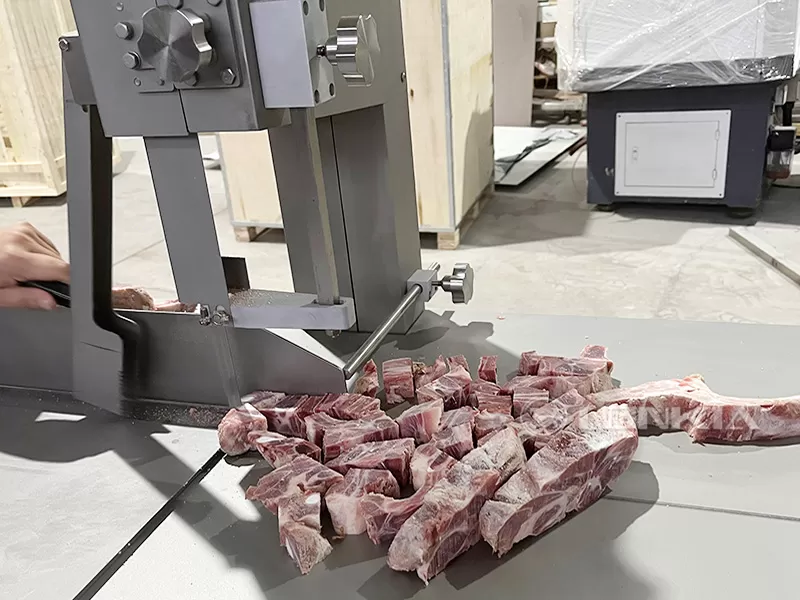Cutting frozen meat and bones is often a challenge in the meat processing industry. Due to their tough structure, cutting them by hand is time-consuming and prone to uneven cuts. Using a meat bone saw machine for frozen meat and bones not only improves efficiency, but also ensures uniformity and precision in cutting. In this article, we will introduce how to properly use a meat and bone saw machine to cut frozen meat and bones to ensure safe operation and cutting results.
Choosing the Right Meat Bone Saw Machine Blade
For cutting frozen meat and bones, choosing the right blade is crucial. Most meat sawing machines come with replaceable blades, and for frozen meat and bones, the hardness and sharpness of the blade is especially important. Generally speaking, blades made of high-strength stainless steel or alloy materials can effectively handle harder materials and reduce the rate of blade wear. Therefore, ensuring that the blade is sharp and suitable for the cutting needs of frozen ingredients is the first step in ensuring a good cut.
Adjusting Cutting Thickness
Electric bone saws usually feature an adjustable cutting thickness. When cutting frozen meat and bones, it is advisable to first adjust the machine's cutting thickness to ensure that the cuts are of uniform thickness. Too thin a cut may result in broken meat during the cutting process, while too thick will waste raw materials and affect work efficiency. Therefore, choosing the right thickness will not only improve the cutting effect but also save raw materials.

Pay Attention to Cutting Speed
When cutting frozen meat and bones, the cutting speed should not be too fast. Although the meat sawing machine can provide fast cutting, for frozen materials, too fast cutting speed may lead to excessive blade wear or uneven cutting. Slowing down the cutting speed appropriately will allow the machine to take full advantage of its benefits and ensure that every cut is flat and smooth.
Regular Cleaning and Maintenance
When using a meat bone saw machine to cut frozen meat and bones, grease and debris from the ingredients may accumulate inside the machine and affect its performance. Regular cleaning and maintenance is especially important to ensure the long-term stable operation of the machine. When cleaning, the blades should be disassembled and thoroughly cleaned, and the sharpness of the blades should be checked and replaced if necessary. Regular lubrication of the moving parts of the machine can effectively reduce mechanical wear and prolong the service life of the machine.
Safe Operation
Safety is always of paramount importance when operating a meat sawing machine. When cutting frozen meat and bones, the hardness of the blade and the speed at which the machine operates make the entire operation risky. To ensure safety, the operator should wear protective equipment, such as gloves and overalls, and ensure that all safety guards are in place. Avoid having your hands near the blades during operation and follow the machine's specifications to avoid accidents.
Conclusion
By properly selecting the blade, adjusting the cutting thickness, controlling the cutting speed, and performing regular maintenance, cutting frozen meat and bones with a meat bone saw machine can greatly improve efficiency and maintain the quality of the cut. As long as you follow the operating specifications and ensure that the equipment is maintained and cleaned, meat and bone sawing machines will play an important role in the processing of frozen meat and bones, helping processors and merchants increase productivity and reduce labor costs.
